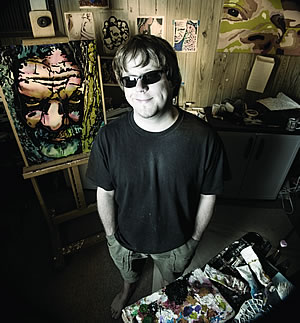August 25, 2009

John Bramblitt
One of the last things John Bramblitt saw before losing his eyesight was the detail of Saturn’s rings in a UNT astronomy lab. Then, he found a new way to explore the world. He began to paint.
When John Bramblitt (’07) completely lost his vision during his freshman year at UNT in 2001, he turned to painting, sometimes spending 16 hours a day at a canvas in addition to attending classes.
“I started to understand the world a little better and think through the depression and frustration,” says Bramblitt, who has battled epilepsy since he was a toddler and believes seizures destroyed his vision. “It forced me to step outside myself and start living in the moment.”
The idea of drawing seemed ridiculous at first, he says, but expressing himself on a canvas was easier at the time than dealing with the three-dimensional world.
“When I paint, I can’t think of anything else — not the next brushstroke, bills I have to pay or a seizure from that morning,” he says.
Using white paint, Bramblitt first draws an outline, then feels his way across the raised edges to paint each color. Most of his works are created with oil paint because each color texture varies in consistency — for instance, he says white is thicker and creamier than black.
“Every emotion I had and thing I touched started to have color because it reminded me of a color I painted with,” he says.
Among his subjects are musicians, street scenes and animals. He says he drew a lot of dogs before getting his guide dog, Echo. He also once arranged a meeting with skateboarder Tony Hawk just to study his face for a painting.
“I see with my hands and am able to take in a lot more information,” Bramblitt says. “I think I have an advantage over sighted artists because I’m completely there, touching the model, asking questions and getting an emotional response.”
During the past eight years, Bramblitt has created more than 100 paintings, which have sold in 20 countries. The 2008 CAP awards, a Dutch awards program honoring the achievements of individuals with disabilities, commissioned him to paint famous Dutch model Reni de Boer, and the prime minister honored his work.
Bramblitt and his wife, Jacqi Serie (’02), production director for the North Texas Daily campus newspaper, celebrated the birth of their first child, Jack, in March 2008. The family travels around the country, hosting and teaching workshops for blind and sighted children, adults and artists.
Bramblitt, whose once daily seizures have drastically reduced in number and severity, credits his perseverance to graduate to the staff in UNT’s Ronald E. McNair Post-baccalaureate Achievement Program. The program guides undergraduate students into graduate study.
“They are brilliant. If not for the constant encouragement of Diana Elrod (director) and Judy Morris (former director) when I was losing my sight, I would have dropped out of school,” he says.
Instead, Bramblitt is planning to return to UNT for graduate school. And he had his first flying lesson this summer as part of a long-term plan to use colored smoke to create abstract art in the air.
“I’m obsessed with painting,” he says. “In expressing myself, connecting with people, it’s become the way I see the world.”